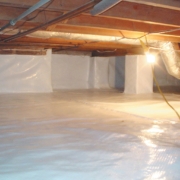Best Practices for Crawl Space Waterproofing
Crawl Space Waterproofing
Is your crawl space a damp and dark space? Such spaces are likely to harbor insects, pests and mold. It is probably a space you never think about and wouldn’t want to enter. This is understandable. However, it doesn’t have to be that way. Crawl space waterproofing can help to convert a dirty, dark and damp crawl space into a clean and dry space that you can use for storage.
If you want to achieve the best results with crawl space waterproofing, it is important to take note of the current best practices. They include:
- Complete encapsulation of the crawl space
In the past, it was believed that the crawl space ought to be vented. This allowed for the circulation of air from the outside into the crawl space. This however has been shown to be counterproductive when it comes to waterproofing a crawl space. Circulation of air from the outside into the crawl space results in letting moisture into the space. It also makes the crawl space a point for heat loss.
Keep the crawl space dry by closing it off completely from the outside. All vents should be closed. Circulation of air within the crawl space can be achieved by connecting it to your HVAC system if necessary.
- Sources of moisture should be attended to first
It is important to determine sources of moisture in the crawl space and attend to them before waterproofing the crawl space. Professional contractors carry out inspections of the crawl space and the entire building to determine sources of moisture including high water tables, roof drainage spills, rising damp and poor grading.
Fixing sources of moisture before waterproofing the crawl space will prevent moisture from penetrating the space in the future. This will help you reap the benefits of waterproofing for the long term.
- Use a 6-mil moisture barrier on the floor
It is important to cover the floor of the crawl space during waterproofing. This will prevent ground water and harmful soil gases from entering the crawl space. Ensure that you use a moisture barrier that is at least 6-mil thick. It is also important to ensure that the barrier is placed over gravel that has been spread in the crawl space and not directly on the soil.
- Periodic inspection of the space
It is important to inspect the crawl space periodically after waterproofing. This will help to ensure that problems are recognized early and attended to before they escalate.




